Jeep Wrangler Sport 4.0 (2001)
|
Time has stood still for the Jeep Wrangler. With the exception of an updated instrument panel and modern controls, it's pretty much sailed through the decades unchanged as a rugged, cross-every-river, climb-every-mountain, feel-every-pothole kind of vehicle that makes no concessions whatsoever to passenger comfort. The last significant mechanical change for the Wrangler came several years ago when coil springs finally replaced the Model T-era leaf springs with which it was previously equipped. We tested the Wrangler Sport 4.0, which has a 4-liter, straight-six engine. It has a target price of $19,000. For $3,500 less, you can get the SE, which has a 2.5-liter, four-cylinder engine in place of the six. All Wranglers come with two half fabric, half metal doors and are available with a five-speed standard transmission or a three-speed automatic. |
|
 |
This is a vehicle with genuine off-road capability. It has part-time four-wheel-drive, a two-speed transfer case, lots of ground clearance, and a rugged suspension. What does all that mean for ride and handling? That means they're nothing short of barbaric, in our humble opinion. You hear and feel every bump in the road. Hitting a bump in the middle of a turn makes the back end jump sideways. If you have the nerve to get it up above 40 miles per hour, a tippy and jittery feeling takes overand we're not just talking about the car.
Noise level is about on a par with the handling, particularly with the roar of the wind across the canvas roof. Jeep says they've added more insulation to the roof this year... which we think means they've just added another layer of duct tape. In fairness to Jeep, we did notice that this one was not quite as noisy as ones we've driven in the recent past. Steering this vehicle is an odd experience. Doug says it reminds him of the Big Wheel trike he rode as a kid, because in both vehicles you're pretty much sitting over the back axles and feel the pivoting under your keister as you turn. It's certainly a different feeling. Anti-lock brakes are a $600 option. Driver and passenger airbags are standard, but side air bags aren't available -- and if there was ever a vehicle that needed side air bags, this is it. (Then again, where would they put them? With no sides, Jeep would be presented with a topological paradox.) The Wrangler scored three stars out of five in the government's rollover-resistance rating, which is as good a score as any sports utility vehicle. Even if it's not prone to tipping over, however, the Wrangler is still not an especially safe vehicle in our opinion. Maybe we're being unreasonable but we'd feel safer in a car with actual, sturdy steel sides to it.
|
 |
As befits this vehicle's character the interior is Spartan. There just aren't that many modern-day vehicles that force you to hoist yourself up and over a tall sill designed to keep floodwaters from sloshing into the footwalls. You're on your own getting in -- we couldn't find any hand-holds or other aids.
Everything on the Wrangler is manual, which is a mixed blessing. The optional windows go up in just a couple of turns of the crank, which is nice, but it's a long reach across the transmission tunnel to get to the passenger-side crank. Likewise, it's hard to reach across and unlock the passenger's door. But, if you're macho enough to drive a he-man vehicle like this, minor inconveniences like these certainly won't present a problem to you.
There's very little room for storage, although you could fit something about the size of a bed pillow in the space behind the back seat. A folding back seat is an extra-cost option on the base model and standard on the Sport. The folding roof is a complete pain in the tuchus, in our humble opinion. It's enough of a geometric challenge to give Buckminster Fuller nightmares. You'll want to keep your eye on the weather forecast, too, because putting the top up isn't something you'll want to figure out while the rain is pouring down. The rear window is big enough to provide good visibility, but it's made of plastic, so you'll have to be careful not to scratch it. Standard accessories include . . . seats. That's about it. There is alsoan AM-FM cassette player. For nearly everything else, prepare to open your checkbook: air conditioning ($895), cruise control ($300), tinted glass ($125). and even body side steps ($75) are optional, while power windows and locks can't be had at any price. |
 |
The other bright spot is the pair of cup holders, placed low to the floor -- no doubt to minimize sloshing. |
 |
|
 |
Both the four- and the six-cylinder engine in the Wrangler have been around forever. They're bullet proof. And both the manual and automatic transmissions have decent reliability records. Wrangler owners who completed our Car Talk survey had about a third lower repair costs when compared with owners of other American-made cars of the same vintage. |
 |
The basic design of the Jeep Wrangler hasn't changed in years. It's pretty straightforward to maintain and service. Mechanics have had plenty of opportunities to learn about the inner workings of the Jeep Wrangler, over the last four decades. |
 |
The fact is, there's not much else being made in the world today that's like the Wrangler. For sheer off-road capability, there's the Land Rover Discovery, but that's another $15,000. The Geo Tracker, now Chevrolet Tracker, used to be a Jeep clone, but it's gotten bigger and heavier and now comes as a four-door, steel-roofed SUV. The Wrangler is no bargain at $19,000-plus, in our humble opinion.But, if you must have a Jeep -- and you know who you are -- there just aren't any comparable alternatives. If you live out at the end of a logging road in the deepest part of the forest, the Jeep Wrangler may just be the perfect vehicle for you. Think of it as a Conestoga wagon with a windshield, and you won't be that far off.
|

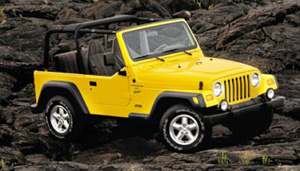
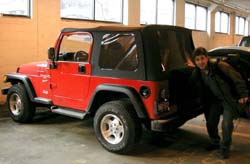 The ride is so unpleasant that when our esteemed producer, Doug Berman, suggested taking the Wrangler on a 20-minute trip, his wife protested. (Bear in mind, as her marriage to Dougie would indicate, this is a woman who ordinarily has a high tolerance for annoyance and pain.)
The ride is so unpleasant that when our esteemed producer, Doug Berman, suggested taking the Wrangler on a 20-minute trip, his wife protested. (Bear in mind, as her marriage to Dougie would indicate, this is a woman who ordinarily has a high tolerance for annoyance and pain.)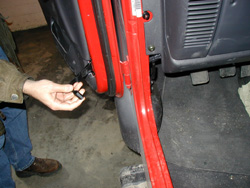 Take a look at the flimsy metal door on your way in -- that's a genuine nylon strap keeping the door from flying open 180 degrees and whacking the paint on the fender. (By the way, those metal doors, like so many other things on the Wrangler, are an option. They cost $125 each.)
Take a look at the flimsy metal door on your way in -- that's a genuine nylon strap keeping the door from flying open 180 degrees and whacking the paint on the fender. (By the way, those metal doors, like so many other things on the Wrangler, are an option. They cost $125 each.)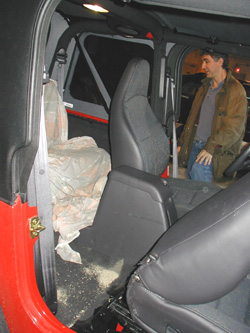 Jeep says there's room for four inside. But choose your rear-seat passengers carefully -- make sure they're children, or sacks of compost, or someone who can't write you out of his will. The tiny, hard bench in the back isn't a place where you'd want to spend much time.
Jeep says there's room for four inside. But choose your rear-seat passengers carefully -- make sure they're children, or sacks of compost, or someone who can't write you out of his will. The tiny, hard bench in the back isn't a place where you'd want to spend much time.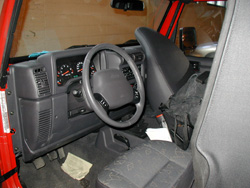 The folks at Jeep have finally put a modern dashboard in the Wrangler, and it's a great improvement over what was there before. The controls are easy to find and operate.
The folks at Jeep have finally put a modern dashboard in the Wrangler, and it's a great improvement over what was there before. The controls are easy to find and operate.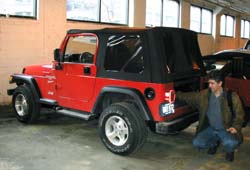 The rugged, outdoorsy, twigs-in-your-hair styling is the Wrangler's major selling point. Buyers no doubt think it's cool and distinctive. It's not simply a retro design, like the Chrysler PT Cruiser or the Volkswagen New Beetle -- the Wrangler is a genuinely old design, not much changed since Ernie Pyle was slogging his way across Normandy.
The rugged, outdoorsy, twigs-in-your-hair styling is the Wrangler's major selling point. Buyers no doubt think it's cool and distinctive. It's not simply a retro design, like the Chrysler PT Cruiser or the Volkswagen New Beetle -- the Wrangler is a genuinely old design, not much changed since Ernie Pyle was slogging his way across Normandy.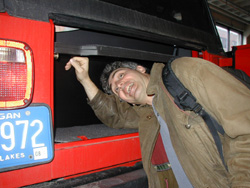 All in all, it must be said that there is a novelty factor in driving such a deliberately unrefined vehicle -- particularly for us, who hoisted our derrieres out of this Jeep and then into a $90,000 Jaguar that was loaned us. But there's a novelty factor to a Turkish jail, too, and a question about how quickly the novelty would wear off. However, there are certain people who absolutely love Jeep Wranglers, and no discussion of reliability or comfort will dissuade them. And, you may be one of them.
All in all, it must be said that there is a novelty factor in driving such a deliberately unrefined vehicle -- particularly for us, who hoisted our derrieres out of this Jeep and then into a $90,000 Jaguar that was loaned us. But there's a novelty factor to a Turkish jail, too, and a question about how quickly the novelty would wear off. However, there are certain people who absolutely love Jeep Wranglers, and no discussion of reliability or comfort will dissuade them. And, you may be one of them.